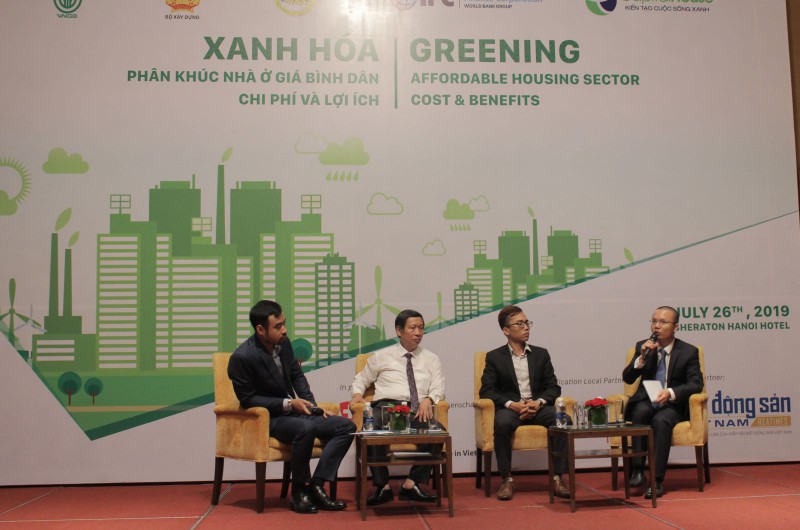At the workshop "Greening affordable housing segment: Costs and benefits" organized by Vietnam Real Estate Association (VNREA) in collaboration with International Finance Organization (IFC) and Capital House, Vu Hong Phong, a specialist on green buildings of IFC said, referring to the term "green building", many people think of the expensive solutions that only rich people could afford, for example, using solar power, planting trees on roof, etc.
Phong said Vietnam could make green construction much cheaper. In developing countries with rapid construction, the use of EDGF – a green building certification system focused on making new residential and commercial buildings more resource-efficient – can help overcome market shortcomings while only driving construction costs up by one or two percent.

Green building experts and real estate developers discuss the development of affordable green housing in Vietnam.
Nguyen Viet Chien, General Secretary of VNREA said investing in affordable housing projects would bring positive results for property developers. This market segment could ensure social security for people, especially low income earners in big cities, and ensure the property market continues to develop in a sustainable way.
He noted: “The affordable housing market has been talked about much in the past three years as real demand for the segment was always more than 80 percent.”
According to a survey by VNREA, housing demand for the middle- and high-end segment with selling prices of over VND25 million per sqm only accounted for 20 to 30 percent and was mainly focused in major cities. Demand for affordable housing priced below VND25 million per sqm made uo 70 to 80 percent. But there was not enough affordable housing on the market to meet the demand.
VNREA expected with the rapid urbanisation rate, 40 percent of Vietnam population of 100 million people would live in urban areas by 2020. Major cities with populations of more than 1.7 million people would struggle to provide accommodations for everyone. In order to meet the demand, Vietnam needs to build about 700,000 apartments by the end of 2020.
High demand in the affordable housing sector would provide a good opportunity for real estate developers in the long term and they should consider adjusting their business strategies accordingly, it added.
Chien pointed out: “This is good news for the market and for low-income earners. However, developers’ shortcomings and tightening credit policies in the market have been obstacles to the segment’s growth."
Those who live in green buildings enjoy a more convenient life, improved health and decreased power and water costs, said Trinh Tung Bach, director of the R&D Department at Capital House Group, which received the EDFG certification for its EcoHome 3 affordable housing project.
He said: “Our apartments were sold more quickly thanks to applying green criteria in our desig. The rapid sale offset for the higher cost of greening our apartments and reducing marketing costs."
Customers at Capital House’s projects saved 25 percent on electricity and 36 percent on water bills, Bach added.
Bach concluded that green buildings are inevitable but green buildings for affordable housing have not attracted strong attention of the people. The deployment of green solutions at low and medium-end housing projects is an inevitable trend to create sustainable development communities and environmental protection.

















